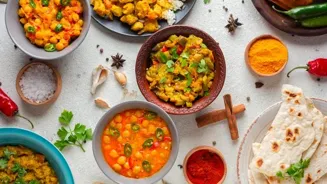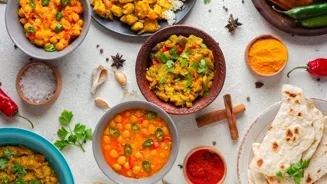Dive into the rich tapestry of Indian cuisine and geography. Explore how landscapes shape flavors in a culinary journey
India, a land of vibrant cultures and breathtaking landscapes, boasts a cuisine as diverse
as its geography. From the snow-capped Himalayas to the sun-kissed beaches of the south, the country's varied terrain has profoundly shaped its culinary traditions.
The availability of local ingredients, influenced by climate, soil type, and altitude, is the cornerstone of India's regional specialties. A culinary journey through India is, therefore, a geographical exploration, with each dish telling a story of the land from which it originates.
The fertile plains of Punjab yield an abundance of wheat, the staple for hearty rotis and parathas. The coastal regions of Kerala, blessed with coconut groves and spice plantations, offer a symphony of flavors in their seafood curries and vegetarian dishes.
Geographical influence on Indian cuisine by climate and ingredients
The geographical influence on Indian cuisine extends beyond the availability of ingredients. The climate plays a crucial role in determining the cooking methods and the types of dishes preferred in different regions.
In the hot and arid regions of Rajasthan, dishes are often prepared with minimal water and rely on ingredients that have a long shelf life. Pickles, chutneys, and dried vegetables are staples, preserving the bounty of the land for leaner times.
In contrast, the humid climate of West Bengal favors dishes with cooling properties. Fish, lentils, and vegetables are cooked in light broths and tempered with spices that aid digestion.
The use of fermentation techniques, such as in the making of idlis and dosas, not only enhances the flavor but also preserves food in the tropical climate.
Northern cuisine rich, hearty; Punjab's sarson ka saag, Kashmir's warming spices unique
In the northern regions, where temperatures can drop significantly, the cuisine is rich and hearty, designed to provide warmth and sustenance. Dishes like sarson ka saag and makki di roti, made from mustard greens and cornmeal, are winter staples in Punjab.
The use of ghee, a clarified butter, is prevalent, adding richness and promoting warmth. In the mountainous regions of Kashmir, the cuisine is characterized by the use of dried fruits, nuts, and warming spices like saffron and cardamom.
The long, cold winters necessitate the preservation of food, leading to the development of unique culinary traditions such as the drying of vegetables and fruits. The connection between the land and the plate is undeniable, with each region showcasing its unique culinary identity.
Assamese cuisine reflects region's abundance, freshness, and unique flavors
Moving towards the east, the cuisine of Assam is influenced by the region's abundant rainfall and fertile soil. Rice is the staple grain, and fish is a widely consumed protein source. The use of bamboo shoots, a locally abundant ingredient, adds a distinctive flavor to many Assamese dishes.

The cuisine is often light and refreshing, reflecting the humid climate. In the northeastern states, the cuisine is characterized by the use of indigenous herbs and spices, many of which are unique to the region.
The focus is on fresh, seasonal ingredients, and the cooking methods are often simple, preserving the natural flavors of the ingredients. The geographical isolation of the region has contributed to the preservation of these unique culinary traditions.
The diverse coastal cuisine of western India
The western coast of India, stretching from Gujarat to Maharashtra, boasts a cuisine that reflects the region's maritime history and diverse cultural influences. Seafood is abundant, and the use of coconut is prevalent.
The Goan cuisine, influenced by Portuguese rule, features a unique blend of Indian and European flavors. Vindaloo, a spicy curry made with vinegar and chilies, is a testament to this culinary fusion. The Maharashtrian cuisine is characterized by its use of spices and lentils.
The vegetarian dishes are particularly noteworthy, with a wide variety of preparations using locally grown vegetables. The Gujarati cuisine is known for its sweetness and the use of a variety of lentils and vegetables.
The coastal location has undoubtedly enriched the culinary landscape, making it a delightful place.
South Indian cuisine: Rice, spices, lentils, and veggies create culinary treasure
The southern regions of India, including Tamil Nadu, Karnataka, and Andhra Pradesh, are renowned for their rice-based cuisine and the liberal use of spices. Sambar, a lentil-based vegetable stew, and rasam, a tangy soup, are staples in Tamil Nadu.
The use of coconut milk and curry leaves is prevalent, imparting a distinct flavor to the dishes. The cuisine of Andhra Pradesh is known for its spiciness, with the use of chilies being a defining characteristic.
Hyderabadi biryani, a fragrant rice dish cooked with meat and spices, is a culinary masterpiece that reflects the region's rich cultural heritage. The geographical diversity within the region, from the coastal plains to the Deccan Plateau, has contributed to the variety of culinary traditions.
The emphasis on rice, lentils, and vegetables, combined with the creative use of spices, makes south Indian cuisine a culinary treasure.
AI Generated Content. Glance/InMobi shall have no liability for the content









